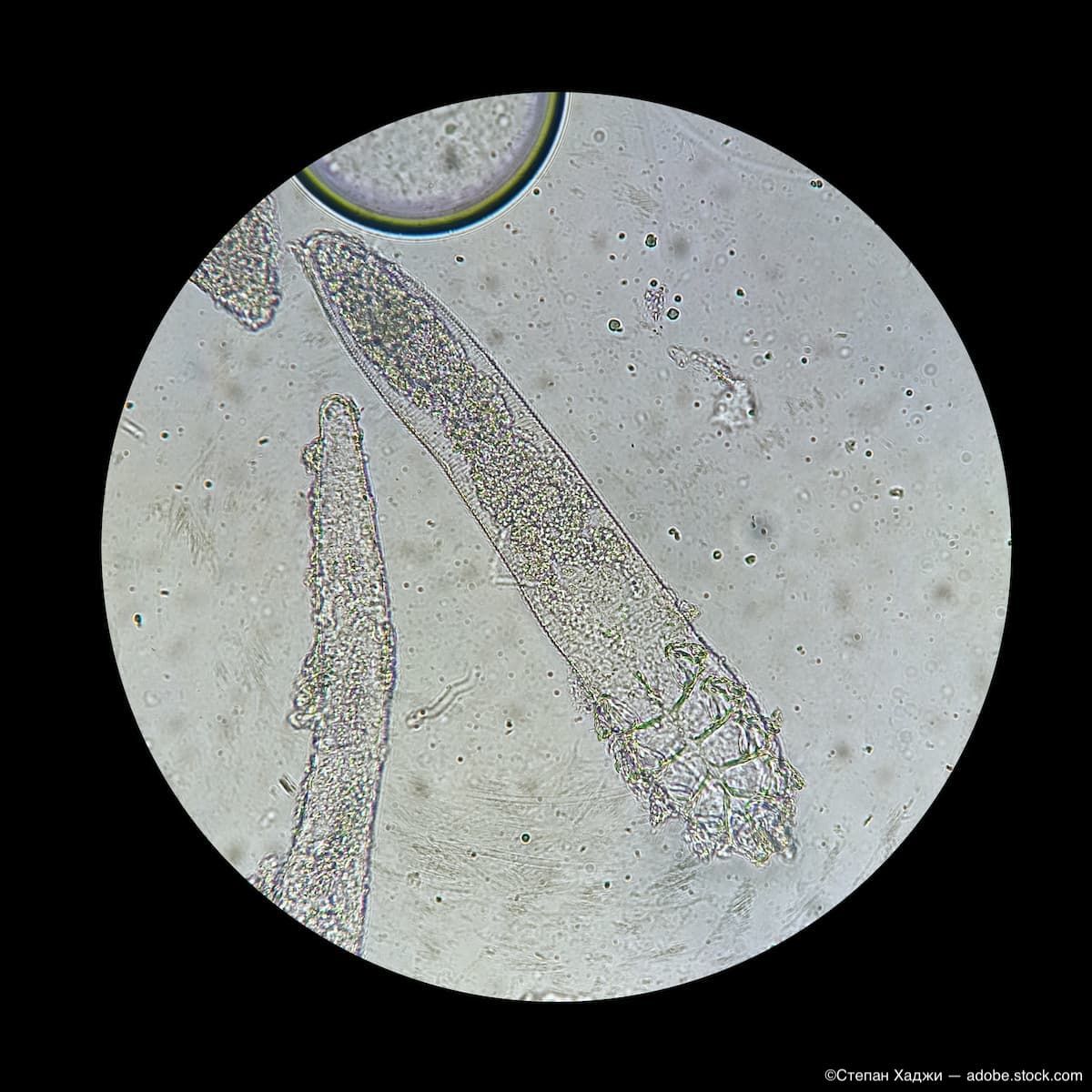Diagnosing and treating Demodex blepharitis
There may not be a standard regime to eradicate the parasites, but treatment options do exist.
Image Credit: AdobeStock/СтепанХаджи

Everything, no matter how minute, has a purpose and so that must also be the case for the pesky Demodex mite, the infective parasites that lie between or on the eyelashes in highly sebaceous areas. Some researchers think these parasites may help control bacterial populations through their acidic secretions. However, their waste can cause inflammation and hypersensitivity reactions in affected individuals.
A recent Optometry Times roundtable series looked at Demodex blepharitis head-on to determine effective diagnostic and treatment strategies.
A key factor in dealing with Demodex mites is an understanding of their life cycle, according to Amy Nau, OD, who is in private practice at Korb and Associates in Boston, Massachusetts. She explained that after females mate, they lay 15 to 20 eggs about 12 hours later. About 3 days later, the eggs hatch and they turn into larva. After about another week, they start reproducing.
Key take-home points from the roundtable discussion regarding the best practices for treating and diagnosing Demodex mites include the following:
- Regardless of the treatment of choice, patient compliance is critical for the successful eradication of the mites.
- Many clinicians assume patients have mites until proven otherwise.
- If clinicians observe collarettes in an asymptomatic patient, they may recommend the use of a tea tree oil base in addition to scrubbing the eyelids. If the patient is symptomatic, hypochlorous acid can be used to mechanically wash the eyelids, with special attention paid to thorough cleaning technique because the mites can hide in hard-to-reach places.
- The website of Tarsus Pharmaceuticals, the manufacturer of lotilaner ophthalmic solution 0.25% (Xdemvy), can be useful in promoting treatment adherence; some doctors use patient handouts to promote treatment compliance.
- Patients who wear contact lenses and those who began using contacts as children ultimately deal with Demodex mites, with perhaps a lifetime of infestation and inflammation.
Nau offered her treatment guidelines after she evaluates a patient: “For a patient with a few mites, I likely will not treat. However, when more than 5 mites are observed, in light of their frequent reproduction cycle and persistence, clinicians should monitor these patients and then decide the treatment course.” She advised being alert for eyelid thickening and redness, itching, and collarettes.
Treatment approaches
There is no standard treatment regimen for Demodex mites, although the first and only treatment, Xdemvy, was approved by the FDA in July 2023.
Nau commented about the popularity of Xdemvy among clinicians. Results from Saturn-2 have shown that cure rate (2 or fewer collarettes) was 56.0% compared to 12.5% in vehicle.1 In addition, the number of collarettes was reduced to fewer than 10 in 90% of patients compared to 14.6% vehicle.1 She recommends that because of the residual collarettes, the focus should continue to be on hygiene, although not every mite needs to be eradicated.
The use of hypochlorous acid solutions has proliferated, Nau mentioned. While these products rid the skin of dirt, they are not effective against mites. Nau advises switching the patient to something else.
Tea tree oil is often the first approach due to its anti-microbial, anti-fungal, and anti-inflammatory effects. However, pure tea tree oil can cause dermatitis. At the other end of the spectrum, 2% tea tree oil may not be sufficiently strong to eradicate the mites.2
Another option is a mixture of 50% coconut oil with tea tree oil and Manuka honey. Raw Manuka honey is too acidic, does not spread well, and is poorly tolerated by the ocular surface. For improved spreading of the honey, Nau recommended using Manuka honey preparations that have already been chemically altered for use on the ocular surface, rather than home-based formulations.
Regardless of the treatment choice, the trick seems to be getting the treatment into the tiny spaces in which the Demodex mites reside. Microblepharoexfoliation with a cotton swab or an okra eyelid patch is a cleaning option.
ZEST (Zocular Eyelid System Treatment) is an in-office treatment that includes a solution and a lid cleaner, and clinicians consider the product to be most effective for this patient population.
Clinicians are strongly advised to talk with patients about their use of makeup and, especially, eyelash extensions, which prevent proper cleaning because of the glue used to keep them in place. Some cliniciansrecommend cleaning products from companies such as Twenty Twenty Eyecare or Eyes Are the Story.
Intense pulsed light (IPL) therapy targets a receptive chromophore in the mites that ultimately results in the mites undergoing coagulation necrosis; 1 treatment session results in about 60% eradication; 2 sessions, almost 70%; and 3 sessions, 83%. Cost is a consideration for medical practices because the IPL units run about $110,000 each.
There remains a question about whether IPL works in combination with other treatments; that is, if IPL would help another treatment work faster. The IPL effect in combination with another treatment remains to be determined.
An anti-parasitic drug, ivermectin cream (Soolantra; Galderma Laboratories), gets high marks from clinicians for treating rosacea associated with a Demodex infestation. Clinicians reported prescribing the drug every day for a month and then having the patients return for reexamination, at which time, depending on the status of the skin, the drug can be stopped; the patients then can be reexamined in another 2 months. An important point is that the clinicians are working with dermatologists, who are experts in general skin care. Another effective regimen may be the application of the drug for 15 minutes once a week for 1 month.
References
Gaddie IB, Donnenfeld ED, Karpecki P, et al; Saturn-2 Study Group. Lotilaner ophthalmic solution 0.25% for Demodex blepharitis: randomized, vehicle-controlled, multicenter, phase 3 trial (Saturn-2). Ophthalmology. 2023 Oct;130(10):1015-1023. doi:10.1016/j.ophtha.2023.05.030
Wallengren J. Tea tree oil attenuates experimental contact dermatitis. Arch Dermatol Res. 2011 Jul;303(5):333-8. doi: 10.1007/s00403-010-1083-y

Newsletter
Want more insights like this? Subscribe to Optometry Times and get clinical pearls and practice tips delivered straight to your inbox.